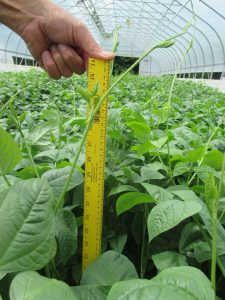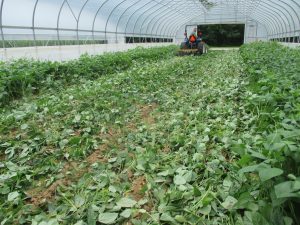We have grown strawberries from Aug, 2015 to May, 2016 in one of our high tunnels at Southwest Purdue Agricultural Center. After taking the strawberry plants out of the high tunnel in the end of May, we did have enough time to grow a warm-season crop, like cucumbers. However, because for most of us June is such a busy time working in the field, we decided to put cover crops inside the high tunnel in the summer months and plant cool-season crops in the fall.
Our primary goal of growing cover crops is to provide nitrogen for the following crops and increase soil organic matter. We decided to use a legume cover crop cowpea in this case because it has excellent drought and heat tolerance. Cowpea at a rate of 100 lbs per acre was sowed on June 17th. With the high temperatures inside the high tunnel, cowpea reached 30’’ high after 5 weeks (Figure 1). Decomposition of the biomass normally takes 3 to 4 weeks after they are incorporated into the soil. We tilled the cover crops on July 25th when they are still in vegetative growth (Figure 2), with the hope that most of the biomass will be decomposed by the end of August at the time we plant fall crops.
An important question now to ask is how much nitrogen (N) will be contributed by cowpea to the following crops? It should be clear that not all the N in the cover crop is available for the next crops after the cover crops being incorporated into the soil. Part of the N is tied up with carbon to form soil organic matter. The remaining N that is readily available for the following crop is called plant available nitrogen.We used a tool developed by Oregon State University to estimate the plant available nitrogen (https://catalog.extension.oregonstate.edu/sites/catalog/files/project/pdf/pnw636.pdf). About 40 lb/a N was provided by cowpea in the five-week period inside the high tunnel, which is about one third of the nitrogen needed for a cool-season crop.
A point that might be raised is that summer is a valuable time to grow cash crops, not cover crops. This statement might be true for field production. However, temperatures inside of high tunnel in the summer can easily reach 100 °F, which make the traditional crop growing season a little too hot for some vegetable crops. In this case study, we demonstrated that a large amount of nitrogen could be provided by legume cover crops growing in high tunnels in a relatively short period of time, indicating summer might be a window for high tunnel growers to work on improving soil fertility by growing legume cover crops. Furthermore, studies have shown that legume cover crops could be a more economic source of N compared with organic fertilizers, an important consideration, particularly for organic growers.

